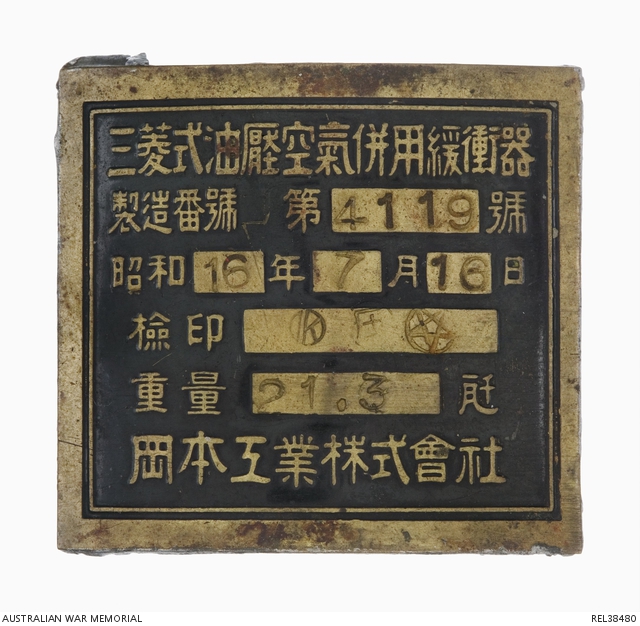| Place | Asia: Malaysia, Labuan |
|---|---|
| Accession Number | REL38480 |
| Collection type | Technology |
| Object type | Aircraft component |
| Physical description | Copper, Enamel, Metal, Solder |
| Maker |
Tachikawa |
| Place made | Japan |
| Date made | c 1941 |
| Conflict |
Second World War, 1939-1945 |
Tachikawa Ki-54c 'Hickory' aircraft oil and pressure shock absorber plate : Warrant Officer L A Pearce, RAAF

Ki-54C aircraft plate. Rectangular copper metal plate slightly curved with Japanese kanji figures both stamped and embossed into the front surfaces. Within the front surface is a rectangular shaped black enamel painted area with a thin black enamel line around the outside. There are small remnants of the retaining solder still existent on parts of the outside edge.
The Tachikawa Ki-54c was a twin-engined light transport and communication aircraft used by the Imperial Japanese Army during the Second World War. The Ki-54 was assigned the codename 'Hickory' by the Allies and by this name it is better known. The aircraft was flown by two aircrew and equipped with eight passenger seats in the cabin. Other versions of the 'Hickory' were used for training for aircrew and anti-submarine warfare during the war. As a crew trainer and light transport, the Ki-54 was one of the most successful Japanese aircraft of the war. A total of 1,368 Ki-54s were built by Tachikawa between 1940 and 1945.
This particular manufacturers plate is originally from the shock absorber assembly of a Tachikawa made Ki-54c 'Hickory' transport plane of the 10th Independent Air Brigade, Imperial Japanese Army which carried the Japanese Borneo land forces surrender delegation to Labuan, Borneo on 10 September 1945.
The senior officer of the surrendering delegation was Lieutenant General Masao Baba, Commander of the Japanese 37th Army and Supreme Commander of Japanese forces in Borneo. There are several high quality images of this aircraft and its historically significant last war-time flight with General Baba within the National Collection. In several of the images it can been seen that the aircraft was finished in a mottled green paint scheme over the original natural metal finish as a means of camouflage. Prominent white crosses had been hand painted by the surrendering Japanese on the fuselage sides and on the upper and lower wing surfaces as per instructions given by the Allies. The crosses on the fuselage are directly over the red circle 'hinomaru' or rising sun markings, while those on the wings are inboard of the Hinamaru. On the tail of the aircraft were the distinctive unit markings of the Imperial Japanese Army 10th Dokuritsu Hikodan Shireibu (10th Independant Air Brigade). In a common practice of Imperial Japanese Army Air units, the unit markings represent the number '10'. During the course of the Second World War a total of 1,368 Ki-54 'Hickory' aircraft of various sub-types were built between 1940-45. The 'Hickory' was a popular, effective and versatile training, transport and communications aircraft of the Imperial Japanese Army.
The label was translated by Memorial staff and reads: 'Mitsubishi type oil and air pressure shock absorber, Production No.4119, Production date 16 July 1941, Inspection seal, Weight 21.3kg, Okamoto Industry Co'. Of note is that the weight mentioned is likely to be the amount of pressure that this particular shock absorber can take rather than the weight of the shock absorber itself.
The particular plate was removed from the 'Hickory' whilst it was at Labuan along with a plate from the other shock absorber on the other landing gear by 300276 Warrant Officer Leonard Anthony Pearce of Brunswick, Vic. Pearce enlisted in the RAAF in Laverton, Vic, on 1 December 1931. Pearce had several postings within the RAAF with various units including 1 and 21 Squadrons and time as an instructor based at the Melbourne Showgrounds. In 1945 he was posted to Borneo and served in Labuan and Morotai before returning to Australia where he was discharged on 21 December 1945.
Share this page
Related information
Conflicts
Places
Related Objects
- Tachikawa Ki-54c 'Hickory' fuselage : 10th Independent Air Brigade, Imperial Japanese Army Air Force
- Studio portrait of 300276 Warrant Officer Leonard Anthony Pearce, 47 Operational Base Unit, RAAF, ...
- Nose art on a B24 Liberator aircraft: "My heart belongs to Daddy". The aircraft was one from the ...
- Lieutenant General Masao Baba, Commander of the Japanese 37th Army and Supreme Commander of ...
- Lieutenant General Masao Baba, Commander of the Japanese 37th Army and Supreme Commander of ...